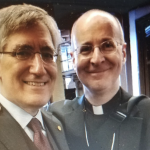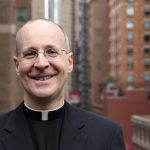Before YouTube, access to diverting video was controlled by middle-school teachers. If students were particularly good, the film-projector appeared to offer relief from the day’s lessons. My favorite, and I’m confident this judgment is shared by others, was footage of the Tacoma Narrows Bridge collapse of 1940.
The world’s third-longest suspension bridge, it famously swayed in the wind, earning the nickname “Galloping Gertie.” Collapsing just months after opening, it provided spectacular, even mesmerizing images as it twisted and bucked, cars sliding from side to side, before falling into Puget Sound.
Those images came to mind upon reading the new book by Fr. James Martin, SJ, Building a Bridge: How the Catholic Church and the LGBT Community Can Enter into a Relationship of Respect, Compassion and Sensitivity. Like the Tacoma Narrows, a bridge is needed, but Martin’s is too flawed to serve its purpose.
Fr. Martin is a winsome and accomplished voice, a sophisticated and media-savvy author of numerous books on religion, with a knack for explaining how Jesuit (or Ignatian) spirituality relates to the contemporary world. He has also, as he explains in Building a Bridge, “ministered to and worked with LGBT people, most of them Catholics,” for many years, attentively and compassionately listening “to their joys and hopes, their griefs and anxieties, sometimes accompanied by tears, sometimes by laughter.” He also knows many in the hierarchy of the Church, and between these two he has “discovered a great divide.”
Start your day with Public Discourse
Sign up and get our daily essays sent straight to your inbox.According to Martin, the LGBT community remains largely “invisible in many quarters of the church,” with LGBT Catholics ignored or insulted by the hierarchy. Consequently, “one part of the church is essentially separated” from another, and “a chasm has formed.” While he hesitates to “refer to two ‘sides,’ since everyone is part of the church,” many LGBT Catholics have told him “they have felt hurt by the institutional church—unwelcomed, excluded, and insulted.”
Instead, Martin offers a bridge, drawing on the Catechism of the Catholic Church’s instruction to treat homosexuals with “respect, compassion, and sensitivity.” It is, he insists, a “two-way bridge,” and he offers guidance to both the hierarchy and members of the LGBT community on approaching and accompanying the other.
Fr. Martin is correct about the need for a bridge. The Church includes all the baptized, and as Pope Francis notes in Amoris Laetitia, all its members are “able to live and grow in the Church and experience her as a mother who welcomes them always, who takes care of them with affection and encourages them along the path of life and the Gospel.” No one of good will or sound conscience would wish for another to wander from “the path of life.”
This is true, but an incomplete truth often ends up a falsehood. To take a theological example, if I affirm that Jesus is God, I have told the truth as orthodox Christians understand it; if I affirm that Jesus is a human, I have told the truth as orthodox Christians understand it. But if I affirm only one of these statements I no longer tell the truth. Unless I include both, the partial truth has become false.
It is certainly true that LGBT Catholics ought to be treated with respect, compassion, and sensitivity, just as LGBT Catholics ought to treat the hierarchy similarly, but leaving it at that is such a partial truth as to turn out false, and Martin does leave it at that, utterly bypassing the central claims at stake, namely, whether homosexual acts are morally permissible or not.
In fact, bypassing the central claims is essential to Martin’s vision of the bridge. Responding to a review of his book in Commonweal by the theologian David Cloutier, Martin notes that Building a Bridge intentionally “never mentions sex, specifically the church’s ban on homosexual activity” since the Church’s “stance on the matter is clear,” as is the LGBT community’s rejection of that teaching. So, Martin continues, “I intentionally decided not to discuss that question, since it was an area on which the two sides are too far apart.”
Despite skirting the point, Martin maintains the importance of encounter, which is “not something to dismiss as out of date, tired or stale. . . . And fundamentally, since the desire for ‘encounter’ is a work motivated by the desire for truth and culminating in the desire for welcome, it must be seen as a work of the Holy Spirit.” Yet genuine encounter, rooted in the desire for truth, could hardly occur in the absence of substantive discussion of the claims made by the Church and those who dissent. Martin’s vision of the bridge turns out to be remarkably facile. It’s a call for civility, but the sort ignoring the substance of the issues and asking both sides to affirm what they believe to be false. I have no doubt the book is well-intentioned, but it is startling in its shallowness.
Fr. Martin avoids all discussion of what the Church teaches regarding sexuality, and of the arguments of those who dissent from that teaching, replacing actual encounter with flaccid and abstract interpretations of respect, compassion, and sensitivity. When defining “sensitivity” Martin appeals to Merriam-Webster’s rather than the Church’s own understanding, long-developed and long-argued, of agape, inculturation, the preferential option, human dignity, solidarity, and so on. That is, in asking for encounter, Martin does not ask the Church to do so in the Christian understanding of encounter, which always includes an anticipation of repentance and conversion. Genuine encounter, for the Church, is not just a respectful meeting, not merely a compassionate sharing, not only a sensitive dialogue—it is always an invitation to the path of life. And given real and substantial disagreements about the truths of that path, it is often a confrontation.
The same occurs with Martin’s discussion of respect. Certainly, all persons are owed respect, but what does that mean? According to Martin, it means, first, that the Church must recognize “that the LGBT community exists” and should receive “the same recognition that any community desires and deserves.” Second, respect means “calling a group what it asks to be called,” for everyone “has a right to the name they wish to be called by.” Third, respect means acknowledging that “LGBT Catholics bring unique gifts to the church—both as individuals and as a community.” Finally, respect means fairness in the workplace, not singling out LGBT employees of the Church in ways not enforced against others who are divorced, or cohabitating, or using birth control, or Protestants, or “not being forgiving, or for not being loving,” or violating Church teaching in some other manner.
All of that contains aspects of the truth, but it asks the Church to jettison its understanding of the truth, that is, to lie about itself in the name of respecting the other. Martin is surely right that it is “common courtesy” to call someone by the name he prefers. If a friend wishes not to be called “Timmy” but “Timothy,” we oblige. Similarly, decency require us to avoid racial, ethnic, gender, and sexual terms that might have previously been common but are now rejected. But Martin does not merely ask the Church to refrain from the term “‘homosexual person,’ which seems overly clinical to many,” but also the phrase “‘objectively disordered’ when it comes to describing the homosexual inclination.” Acknowledging that the phrase describes not the person but the orientation, Martin says it is nonetheless “needlessly hurtful” and “needlessly cruel,” as it says “that one of the deepest parts of the person—the part that gives and receives love—is ‘disordered.’”
However off-putting to contemporary norms, this is not optional phrasing. The Church does in fact claim that homosexual acts—as indeed similar acts between heterosexuals—are “acts of grave depravity,” “intrinsically disordered,” “counter to the natural law,” which can never be approved (Catechism 2357). If the acts are disordered, a desire for those acts is also disordered, and objectively so, for they can never be performed or desired in an ordered, virtuous manner. There’s no way to sugarcoat this—it’s a difficult teaching. Many will find it unpalatable. Many will find it false. But it is, nevertheless, what the Church teaches is true. Asking the Church to set aside the phrasing is tantamount to asking the Church to set aside its understanding of the truth.
A more helpful vision of encounter can be found in a famous essay on interfaith discussions by Rabbi Joseph B. Soloveitchik, tellingly entitled “Confrontation.” The Rav provides a much richer (and more bracingly honest) sense of the difficulties of encounter. He begins at the encounter of Adam and Eve, when “two individuals, lonely and helpless in their solitude, meet, and the first community is formed.” From their solitude, they must “in a unique encounter begin to communicate” when the “miraculous word rises and shines forth.” Adam speaks, addressing himself to Eve, and they can begin to “break through to each other.”
But, notes Soloveitchik, the word is paradoxical and “contains an inner contradiction,” both opening and uniting but also “manifesting distinctness, emphasizing incongruity, and underlining separateness.” The word brings commonality even as it confounds, highlighting the stark unknowability of the other: “the closer two individuals get to know each other, the more aware they become of the metaphysical dance separating them.” Genuine encounter does not ignore difference.
With respect to religious difference, Soloveitchik indicates “a double confrontation.” On the one hand, the person of faith is a human being like every other, sharing the common destiny and nature of Adam. On the other hand, he is a member of “the exclusive covenantal confrontation.” Given this duality, it is naïve (and false in the end) to assume the stance of “single-confrontation,” where the religious simply “stand[s] shoulder to shoulder with mankind” in a universal and generic parlance. Doing so reduces the person to an unencumbered self without thick beliefs and commitments, values and stories, ultimate concerns and traditions; it is possible, says Soloveitchik, only when individuals “are converted into abstractions.” Individual persons are not abstractions, nor are faith communities. In fact, faith communities do not, says Soloveitchik, understand “the divine imperatives and commandments” as “equated with the ritual and ethos of another community,” for each community is “engaged in a singular normative gesture . . . and it is futile to try to find common denominators.” Second, each believes, “and this belief is indispensable to the survival of the community—that its system of dogmas, doctrines and values is best fitted for the attainment of the ultimate good.”
In other words, one cannot understand a faith community—Jewish or otherwise—if the imperatives and commitments of that community are redacted, bracketed away in favor of thin and generic commitments to civility. Such civility produces a false encounter, an encounter of ghostlike abstractions rather than between the flesh and blood of real persons and their commitments. The same would be true between disputants within a community, such as the orthodox and the dissenters on sexual morality.
If a faith community is viewed only as a sociological or political reality, a community in which belonging and recognition are the fundamental point, that is, if one viewed the covenantal community as just another liberal democratic institution whose very mandate was to prescind from substantive truth claims, then, says Soloveitchik, we would have no problem at all meeting “the other on the basis of equality, friendship, and sympathy.” But covenantal faith, to be itself, must maintain a sense of uniqueness, distinction, and difference. Ignoring or evacuating that difference—the hardness of encounter—denies the duality of confrontation by bracketing the community’s ethos, beliefs, and imperatives—which is not respect but negation, not compassion but absorption, not sensitivity but dishonesty.
Such flabby versions of encounter seek commonality, yes, they even seek a kind of truth held in common, but the truth sought is so generic, so abstract, so thinned out as to render particular commitments irrelevant. This is the search for a “truth” so partial, leaving out so much that matters, as to become false. Far better, a bridge going somewhere, is the honest work of confrontation.
Not confrontation in the sense of hostilities or battle, but as Soloveitchik articulated, an attempt to communicate that reveals and (sometimes) reinforces differences. After all, a bridge is needed when there is a chasm or a gulf or a river that cannot be easily crossed. It does no good to paper over differences, to make paper bridges, for reality, as the builders of the Tacoma Narrows Bridge discovered, has a way of making faulty construction known.














